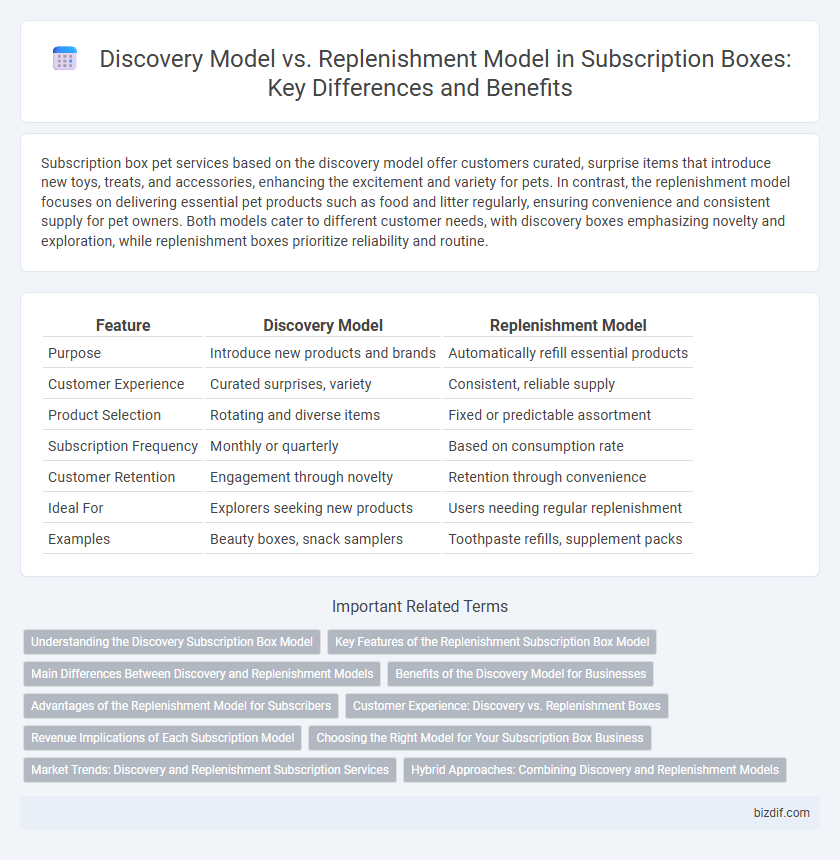Subscription box pet services based on the discovery model offer customers curated, surprise items that introduce new toys, treats, and accessories, enhancing the excitement and variety for pets. In contrast, the replenishment model focuses on delivering essential pet products such as food and litter regularly, ensuring convenience and consistent supply for pet owners. Both models cater to different customer needs, with discovery boxes emphasizing novelty and exploration, while replenishment boxes prioritize reliability and routine.
Table of Comparison
| Feature | Discovery Model | Replenishment Model |
|---|---|---|
| Purpose | Introduce new products and brands | Automatically refill essential products |
| Customer Experience | Curated surprises, variety | Consistent, reliable supply |
| Product Selection | Rotating and diverse items | Fixed or predictable assortment |
| Subscription Frequency | Monthly or quarterly | Based on consumption rate |
| Customer Retention | Engagement through novelty | Retention through convenience |
| Ideal For | Explorers seeking new products | Users needing regular replenishment |
| Examples | Beauty boxes, snack samplers | Toothpaste refills, supplement packs |
Understanding the Discovery Subscription Box Model
The Discovery Subscription Box model emphasizes curating a selection of new and unique products that introduce customers to innovative brands and trends, fostering excitement and surprise with each delivery. This approach contrasts with the Replenishment Subscription Box model, which focuses on supplying regularly used products to maintain consistent consumption. Understanding the Discovery model requires recognizing its role in customer engagement through novelty, exploration, and personalized unboxing experiences.
Key Features of the Replenishment Subscription Box Model
The replenishment subscription box model prioritizes consistent delivery of essential products, ensuring customers never run out of items like toiletries, groceries, or health supplements. Key features include automatic, scheduled shipments based on user consumption patterns, customization options for quantity and frequency, and seamless inventory management that reduces purchase friction. This model enhances customer retention by focusing on convenience, reliability, and personalized product replenishment.
Main Differences Between Discovery and Replenishment Models
The discovery model in subscription boxes emphasizes curated, novel products designed to introduce customers to new brands and experiences, fostering excitement and variety with each shipment. The replenishment model, conversely, focuses on supplying customers with repeat purchases of essential or frequently used items, prioritizing convenience and consistency. Key differences include the discovery model's emphasis on exploration and surprise versus the replenishment model's focus on practicality and product continuity.
Benefits of the Discovery Model for Businesses
The Discovery Model in subscription boxes drives customer engagement by delivering curated, novel products that encourage exploration and brand loyalty. This model boosts average order value and customer retention through personalized, surprise offerings that create excitement and anticipation. Businesses benefit from increased brand awareness, valuable consumer insights, and opportunities to test new products without the risk of inventory overstock.
Advantages of the Replenishment Model for Subscribers
The replenishment model ensures customers receive essential products automatically, reducing the risk of running out and saving time on reordering. This model offers personalized delivery schedules and quantity adjustments, enhancing convenience and satisfaction. Predictable shipments often lead to cost savings through subscription discounts and consistent product availability.
Customer Experience: Discovery vs. Replenishment Boxes
Discovery subscription boxes enhance customer experience by introducing curated, novel products that spark excitement and encourage exploration. Replenishment boxes prioritize convenience and reliability, delivering essential items customers regularly use, thus minimizing effort and ensuring consistent satisfaction. Balancing these models allows brands to tailor experiences that either surprise and delight or streamline shopping needs based on consumer preferences.
Revenue Implications of Each Subscription Model
The discovery subscription model drives higher average revenue per user (ARPU) through curated, limited-time products that encourage frequent purchases and customer engagement. In contrast, the replenishment model generates steady, predictable revenue with recurring orders of essential items, leading to improved lifetime customer value (LCV) and reduced churn rates. Businesses balancing these models can optimize revenue by leveraging the discovery model's upsell potential alongside the replenishment model's stable cash flow.
Choosing the Right Model for Your Subscription Box Business
Selecting the ideal subscription box model hinges on your product type and customer goals; discovery models excel by offering curated, surprise items that enhance customer engagement and attract exploration enthusiasts, while replenishment models cater to convenience by providing regular deliveries of essential products that ensure consistent use and reduce purchase friction. Analyzing customer behavior, product lifecycle, and inventory management strategies helps determine which model maximizes lifetime value and retention rates. Implementing data-driven insights and feedback loops refines the subscription offering, aligning with market demands and fostering scalable growth.
Market Trends: Discovery and Replenishment Subscription Services
Discovery subscription services capitalize on consumer desire to explore new products, driving market growth through curated, surprise offerings that enhance customer engagement and satisfaction. Replenishment subscription models focus on convenience and routine, providing timely deliveries of essential goods to meet consistent demand and foster long-term loyalty. Market trends indicate a rising interest in hybrid models combining discovery and replenishment to maximize customer retention and lifetime value in the subscription box industry.
Hybrid Approaches: Combining Discovery and Replenishment Models
Hybrid subscription box models integrate discovery and replenishment strategies to enhance customer retention and satisfaction. This approach offers curated, personalized products for exploration alongside essential items that customers regularly need, balancing novelty with convenience. Companies leveraging hybrid models report increased engagement rates and higher lifetime value due to tailored product mixes that address diverse consumer preferences.
Discovery model vs replenishment model Infographic

 bizdif.com
bizdif.com